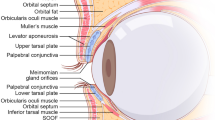Background: Problems with epithelial healing are the main cause of corneal graft failure in patients with limbal stem cell deficiency. This post-operative complication cannot be eliminated by conventional penetrating keratoplasty alone, but only by additional limbal grafting, which is, however, highly immunogenic. We report here our 3 years' experience with a new surgical procedure which we developed called homologous central limbo-keratoplasty.
Patients and methods: We have performed 52 homologous central limbo-keratoplasties in patients with limbal stem cell deficiency since February 1993. We report here the results of the first 18 transplantations with the longest follow-up periods (mean 22 months). The unmatched donor cornea was trephined in a way such that 40 % of its circumference contained limbus. These grafts were then sutured centrally into the host cornea. Systemic cyclosporin A (CSA) was administered for at least 1 year after all transplantations.
Results: Fourteen of the 18 grafts failed during the follow-up period. The reasons for graft failure were severe surface disorders (7), severe surface disorders in combination with endothelial immune reactions (5) and endothelial immune reactions alone (2). The four patients with centrally clear grafts no longer receive systemic CSA with follow-up periods between 20 and 30 months.
Conclusions: Central limbo-keratoplasty is a very promising procedure. However, the average results are not yet satisfying, because the majority of limbal stem cells undergo rejection within 2 years. Improved results will be achievable in the future by using well-matched instead of non-matched transplants and by further improving immune modulation beyond the effectiveness of current CSA treatment.
Ziel: Bei Limbusstammzellschäden sind Epithelheilungsstörungen die häufigste Ursache eines Transplantatversagens. Diese Ursache kann niemals durch eine perforierende Keratoplastik allein, sondern nur durch zusätzliche Limbustransplantate beseitigt werden, die allerdings hochgradig immunogen wirken. Wir berichten über unsere nun 3jährigen Erfahrungen mit der von uns entwickelten Methode der homologen zentralen Limbokeratoplastik.
Patienten und Methode: Seit Februar 1993 haben wir bei insgesamt 52 Patienten mit Limbusstammzellschäden zentrale korneolimbale Transplantationen vorgenommen. Hier werden die Verläufe der ersten 18 aufeinanderfolgenden Transplantationen mit der längsten Nachbeobachtungszeit (durchschnittlich 22 Monate) dargestellt. Die ungematchte Spenderhornhaut wurde derart trepaniert, daß etwa 40 % der Zirkumferenz Limbus enthielten. Es erfolgte eine zentrale Einnähung. In allen Fällen wurde ab dem Operationstag systemisches Cyclosporin A (CSA) über wenigstens 1 Jahr postoperativ appliziert.
Ergebnisse: 14 der 18 Transplantate trübten im Nachbeobachtungszeitraum ein. Ursachen waren 7mal schwere Oberflächenstörungen, 5mal schwere Oberflächenstörungen in Kombination mit endothelialen Immunreaktionen und 2mal nur endotheliale Immunreaktionen. Keiner der 4 Patienten mit klarem Transplantat erhält noch systemisches CSA bei Nachbeobachtungszeiten zwischen 20 und 30 Monaten.
Schlußfolgerungen: Die zentrale Limbokeratoplastik ist ein wertvolles, zukunftsträchtiges Verfahren, dessen durchschnittliche mittelfristige Ergebnisse allerdings noch nicht ganz befriedigen, weil es überwiegend noch zur Immundestruktion des Limbus kommt. Diese Immundestruktion kann nur dadurch verhindert werden, daß man in Zukunft statt der hier verwendeten ungematchten nur noch ideal HLA-gematchte Transplantate benutzt und zusätzlich die CSA-Immunmodulation weiter entwickelt und durch neue Medikamentenkombinationen weiter optimiert.
Similar content being viewed by others
Author information
Authors and Affiliations
Rights and permissions
About this article
Cite this article
Sundmacher, R., Reinhard, T. & Althaus, C. Three years' experience with homologous central limbo-keratoplasty in the treatment of limbal stem cell deficiency. Ophthalmologe 94, 897–901 (1997). https://doi.org/10.1007/s003470050218
Issue Date:
DOI: https://doi.org/10.1007/s003470050218




